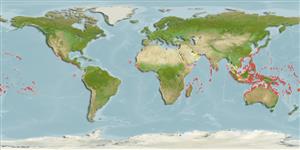Actinopterygii (ray-finned fishes) >
Tetraodontiformes (Puffers and filefishes) >
Monacanthidae (Filefishes)
Etymology: Cantherhines: Greek, kanthos = the outer or inner corner of the eye, where the lids meet, 1646 + Greek, rhinos = nose (Ref. 45335).
Environment / Climate / Range
Ecology
Marine; reef-associated; depth range 2 - 20 m (Ref. 9710). Tropical, preferred ?; 32°N - 32°S
Indo-Pacific: Red Sea south to South Africa (Ref. 4421) and east to southern Japan and southeastern Oceania. Eastern Atlantic: Gulf of Guinea, Annobon Islands, south coast of Africa (Ref. 3592). Replaced by Cantherhines sandwichiensis in the Hawaiian Islands (Ref. 37816).
Size / Weight / Age
Maturity: Lm ? range ? - ? cm
Max length : 25.0 cm TL male/unsexed; (Ref. 3592); common length : 15.0 cm TL male/unsexed; (Ref. 3467)
Dorsal
spines
(total): 2;
Dorsal
soft rays
(total): 32-36;
Anal
spines: 0;
Anal
soft rays: 29 - 32. Can adopt three basic color patterns: mottled grey and brown, dark brown, or grey with a network of close-set polygonal spots. All have a small white spot at the rear base of the second dorsal fin and sometimes the anal fin.
Occurs on outer reef slopes to depths of 2 to more than 20 m (Ref. 1602, 48637), often silty habitats. Young float with loose surface weeds and adults are often with large Sargassum rafts during the wet season (Ref. 48637). Solitary. Feeds on benthic organisms (Ref. 30573). Somewhat secretive (Ref. 9710).
Life cycle and mating behavior
Maturity | Reproduction | Spawning | Eggs | Fecundity | Larvae
Randall, J.E., G.R. Allen and R.C. Steene, 1990. Fishes of the Great Barrier Reef and Coral Sea. University of Hawaii Press, Honolulu, Hawaii. 506 p. (Ref. 2334)
IUCN Red List Status (Ref. 115185)
CITES (Ref. 94142)
Not Evaluated
Threat to humans
Harmless
Human uses
Fisheries: minor commercial
More information
Common namesSynonymsMetabolismPredatorsEcotoxicologyReproductionMaturitySpawningFecundityEggsEgg development
ReferencesAquacultureAquaculture profileStrainsGeneticsAllele frequenciesHeritabilityDiseasesProcessingMass conversion
Tools
Special reports
Download XML
Internet sources
